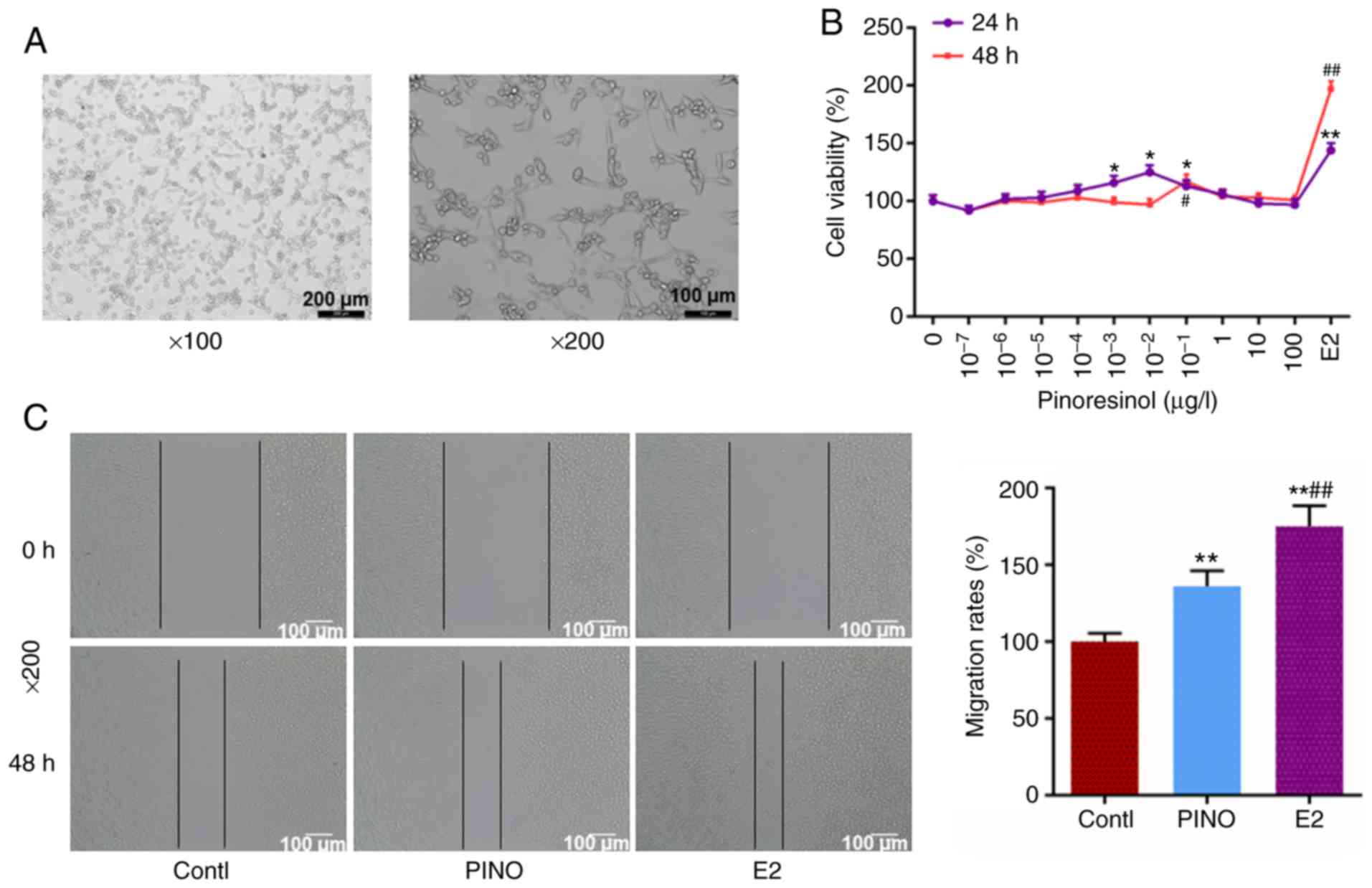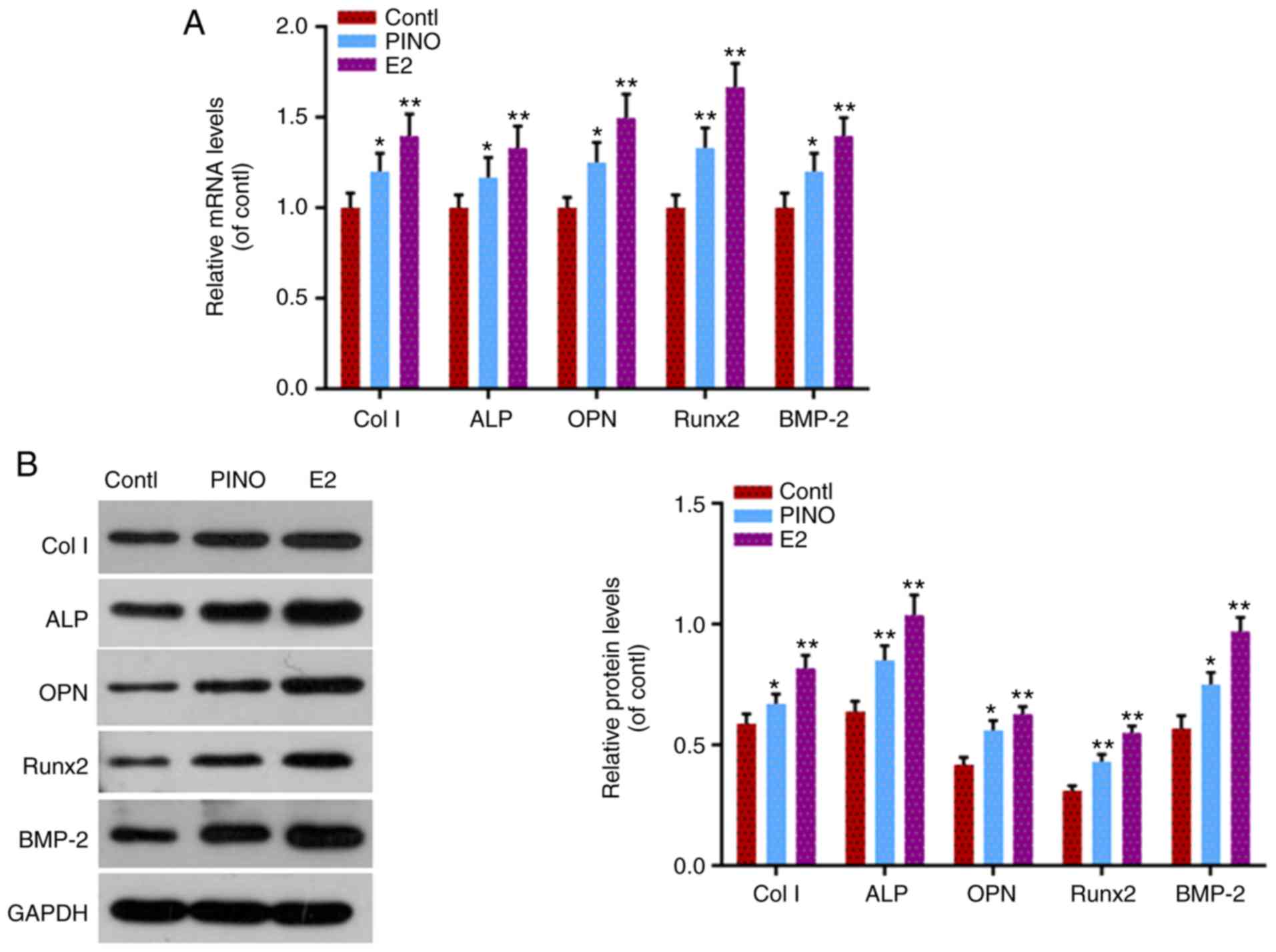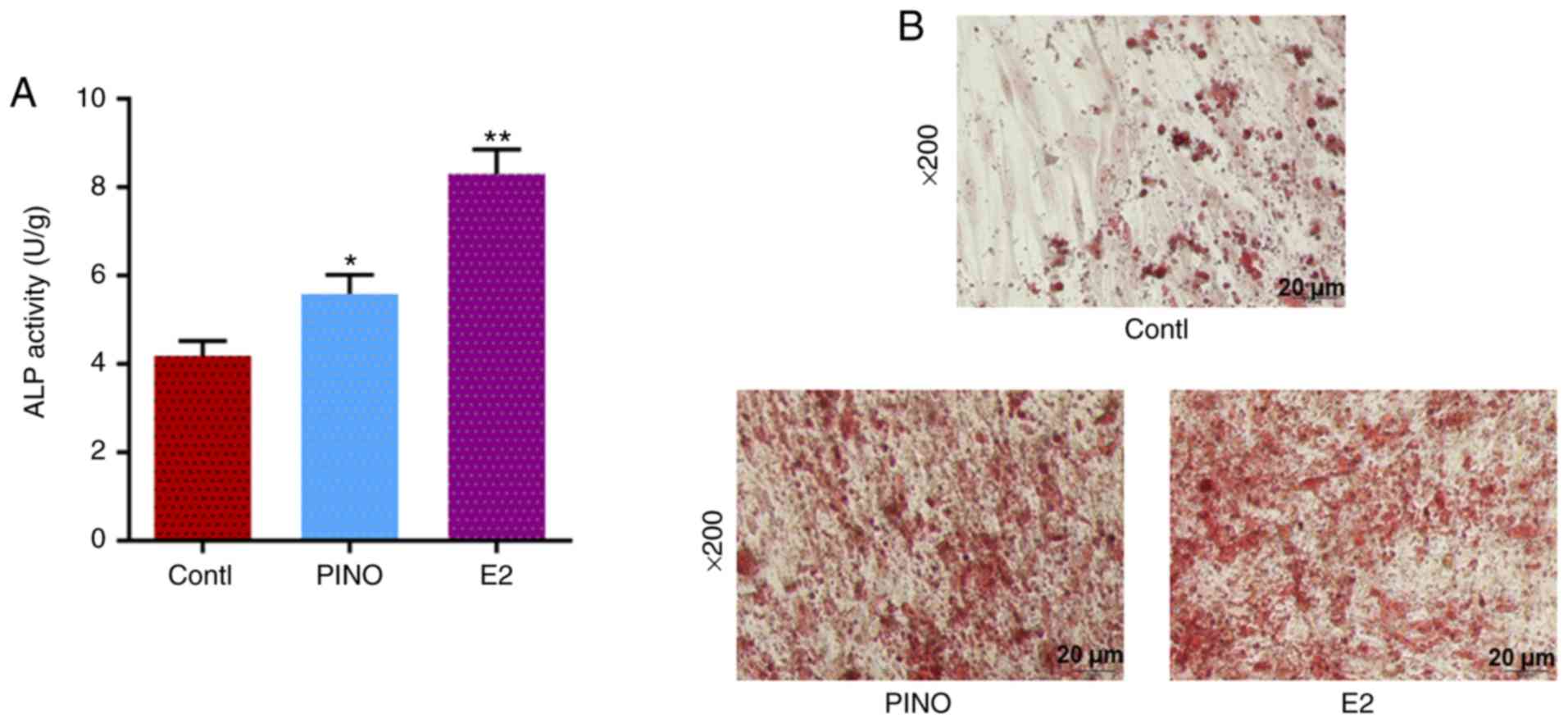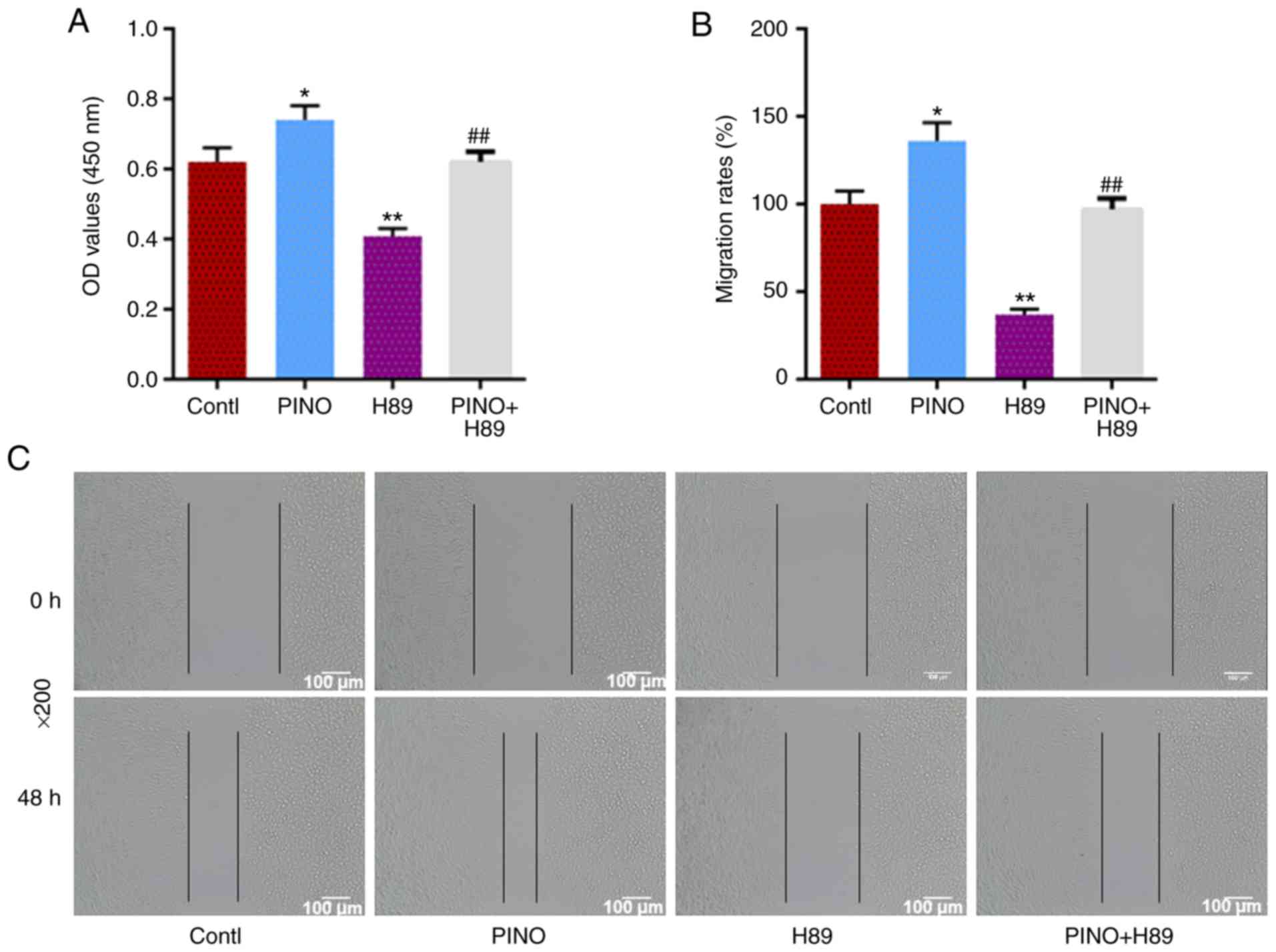|
1
|
Tang D, Ju C, Liu Y, Xu F, Wang Z and Wang
D: Therapeutic effect of icariin combined with stem cells on
postmenopausal osteoporosis in rats. J Bone Miner Metab.
36:180–188. 2018. View Article : Google Scholar : PubMed/NCBI
|
|
2
|
Krege JH and Wan X: Teriparatide and the
risk of nonvertebral fractures in women with postmenopausal
osteoporosis. Bone. 50:161–164. 2012. View Article : Google Scholar : PubMed/NCBI
|
|
3
|
Hannafon F and Cadogan MP: Recognition and
treatment of postmenopausal osteoporosis. J Gerontol Nurs.
40:10–14. 2014. View Article : Google Scholar : PubMed/NCBI
|
|
4
|
Ming LG, Lv X, Ma XN, Ge BF, Zhen P, Song
P, Zhou J, Ma HP, Xian CJ and Chen KM: The prenyl group contributes
to activities of phytoestrogen 8-prenynaringenin in enhancing bone
formation and inhibiting bone resorption in vitro. Endocrinology.
154:1202–1214. 2013. View Article : Google Scholar : PubMed/NCBI
|
|
5
|
Ke K, Li Q, Yang X, Xie Z, Wang Y, Shi J,
Chi L, Xu W, Hu L and Shi H: Asperosaponin VI promotes bone marrow
stromal cell osteogenic differentiation through the PI3K/AKT
signaling pathway in an osteoporosis model. Sci Rep. 6:352332016.
View Article : Google Scholar : PubMed/NCBI
|
|
6
|
Antebi B, Pelled G and Gazit D: Stem cell
therapy for osteoporosis. Curr Osteoporos Rep. 12:41–47. 2014.
View Article : Google Scholar : PubMed/NCBI
|
|
7
|
Vico L and Vanacker JM: Sex hormones and
their receptors in bone homeostasis: Insights from genetically
modified mouse models. Osteoporos Int. 21:365–372. 2010. View Article : Google Scholar : PubMed/NCBI
|
|
8
|
Reginster JY, Pelousse F and Bruyere O:
Safety concerns with the long-term management of osteoporosis.
Expert Opin Drug Saf. 12:507–522. 2013. View Article : Google Scholar : PubMed/NCBI
|
|
9
|
Cosman F: Long-term treatment strategies
for postmenopausal osteoporosis. Curr Opin Rheumatol. 30:420–426.
2018. View Article : Google Scholar : PubMed/NCBI
|
|
10
|
Lewiecki EM: Safety of long-term
bisphosphonate therapy for the management of osteoporosis. Drugs.
71:791–814. 2011. View Article : Google Scholar : PubMed/NCBI
|
|
11
|
Fan JZ, Yang L, Meng GL, Lin YS, Wei BY,
Fan J, Hu HM, Liu YW, Chen S, Zhang JK, et al: Estrogen improves
the proliferation and differentiation of hBMSCs derived from
postmenopausal osteoporosis through notch signaling pathway. Mol
Cell Biochem. 392:85–93. 2014. View Article : Google Scholar : PubMed/NCBI
|
|
12
|
Burkman RT: Hormone replacement therapy.
Current controversies. Minerva Ginecol. 55:107–116. 2003.PubMed/NCBI
|
|
13
|
Komm BS, Morgenstern D, A Yamamoto L and
Jenkins SN: The safety and tolerability profile of therapies for
the prevention and treatment of osteoporosis in postmenopausal
women. Expert Rev Clin Pharmacol. 8:769–784. 2015. View Article : Google Scholar : PubMed/NCBI
|
|
14
|
Canalis E, Economides AN and Gazzerro E:
Bone morphogenetic proteins, their antagonists and the skeleton.
Endocr Rev. 24:218–235. 2003. View Article : Google Scholar : PubMed/NCBI
|
|
15
|
Phimphilai M, Zhao Z, Boules H, Roca H and
Franceschi RT: BMP signaling is required for RUNX2-dependent
induction of the osteoblast phenotype. J Bone Miner Res.
21:637–646. 2006. View Article : Google Scholar : PubMed/NCBI
|
|
16
|
Yang B, Lin X, Tan J, She X, Liu Y and
Kuang H: Root bark of Sambucus Williamsii Hance promotes rat
femoral fracture healing by the BMP-2/Runx2 signaling pathway. J
Ethnopharmacol. 191:107–114. 2016. View Article : Google Scholar : PubMed/NCBI
|
|
17
|
He S, Choi YH, Choi JK, Yeo CY, Chun C and
Lee KY: Protein kinase A regulates the osteogenic activity of
Osterix. J Cell Biochem. 115:1808–1815. 2014. View Article : Google Scholar : PubMed/NCBI
|
|
18
|
Li H, Jeong HM, Choi YH, Kim JH, Choi JK,
Yeo CY, Jeong HG, Jeong TC, Chun C and Lee KY: Protein kinase a
phosphorylates Dlx3 and regulates the function of Dlx3 during
osteoblast differentiation. J Cell Biochem. 115:2004–2011.
2014.PubMed/NCBI
|
|
19
|
Owen RW, Mier W, Giacosa A, Hull WE,
Spiegelhalder B and Bartsch H: Identification of lignans as major
components in the phenolic fraction of olive oil. Clin Chem.
46:976–988. 2000.PubMed/NCBI
|
|
20
|
Sepporta MV, Mazza T, Morozzi G and
Fabiani R: Pinoresinol inhibits proliferation and induces
differentiation on human HL60 leukemia cells. Nutr Cancer.
65:1208–1218. 2013. View Article : Google Scholar : PubMed/NCBI
|
|
21
|
Fini L, Hotchkiss E, Fogliano V, Graziani
G, Romano M, De Vol EB, Qin H, Selgrad M, Boland CR and
Ricciardiello L: Chemopreventive properties of pinoresinol-rich
olive oil involve a selective activation of the ATM-p53 cascade in
colon cancer cell lines. Carcinogenesis. 29:139–146. 2008.
View Article : Google Scholar : PubMed/NCBI
|
|
22
|
García-Martínez O, De Luna-Bertos E,
Ramos-Torrecillas J, Ruiz C, Milia E, Lorenzo ML, Jimenez B,
Sánchez-Ortiz A and Rivas A: Phenolic compounds in extra virgin
olive oil stimulate human osteoblastic cell proliferation. PLoS
One. 11:e01500452016. View Article : Google Scholar : PubMed/NCBI
|
|
23
|
Livak KJ and Schmittgen TD: Analysis of
relative gene expression data using real-time quantitative PCR and
the 2(-Delta Delta C(T)) method. Methods. 25:402–408. 2001.
View Article : Google Scholar : PubMed/NCBI
|
|
24
|
Luo Z, Liu M, Sun L and Rui F: Icariin
recovers the osteogenic differentiation and bone formation of bone
marrow stromal cells from a rat model of estrogen
deficiency-induced osteoporosis. Mol Med Rep. 12:382–388. 2015.
View Article : Google Scholar : PubMed/NCBI
|
|
25
|
Zhu C, Bao N, Chen S and Zhao J: Dioscin
enhances osteoblastic cell differentiation and proliferation by
inhibiting cell autophagy via the ASPP2/NF-κβ pathway. Mol Med Rep.
16:4922–4926. 2017. View Article : Google Scholar : PubMed/NCBI
|
|
26
|
Li B, Hu RY, Sun L, Luo R, Lu KH and Tian
XB: Potential role of andrographolide in the proliferation of
osteoblasts mediated by the ERK signaling pathway. Biomed
Pharmacother. 83:1335–1344. 2016. View Article : Google Scholar : PubMed/NCBI
|
|
27
|
Ma XN, Ma CX, Shi WG, Zhou J, Ma HP, Gao
YH, Xian CJ and Chen KM: Primary cilium is required for the
stimulating effect of icaritin on osteogenic differentiation and
mineralization of osteoblasts in vitro. J Endocrinol Invest.
40:357–366. 2017. View Article : Google Scholar : PubMed/NCBI
|
|
28
|
Shao X, Cao X, Song G, Zhao Y and Shi B:
Metformin rescues the MG63 osteoblasts against the effect of high
glucose on proliferation. J Diabetes Res. 2014:4539402014.
View Article : Google Scholar : PubMed/NCBI
|
|
29
|
Fusaro M, Crepaldi G, Maggi S, D'Angelo A,
Calo L, Miozzo D, Fornasieri A and Gallieni M: Bleeding, vertebral
fractures and vascular calcifications in patients treated with
warfarin: Hope for lower risks with alternative therapies. Curr
Vasc Pharmacol. 9:763–769. 2011. View Article : Google Scholar : PubMed/NCBI
|
|
30
|
Siddiqi MZ, Siddiqi MH, Kim YJ, Jin Y, Huq
MA and Yang DC: Effect of fermented red ginseng extract enriched in
ginsenoside Rg3 on the differentiation and mineralization of
preosteoblastic MC3T3-E1 cells. J Med Food. 18:542–548. 2015.
View Article : Google Scholar : PubMed/NCBI
|
|
31
|
Choi ST, Kim JH, Kang EJ, Lee SW, Park MC,
Park YB and Lee SK: Osteopontin might be involved in bone
remodelling rather than in inflammation in ankylosing spondylitis.
Rheumatology (Oxford). 47:1775–1779. 2008. View Article : Google Scholar : PubMed/NCBI
|
|
32
|
Lee SH, Park Y, Song M, Srikanth S, Kim S,
Kang MK, Gwack Y, Park NH, Kim RH and Shin KH: Orai1 mediates
osteogenic differentiation via BMP signaling pathway in bone marrow
mesenchymal stem cells. Biochem Biophys Res Commun. 473:1309–1314.
2016. View Article : Google Scholar : PubMed/NCBI
|
|
33
|
Nishimura R, Hata K, Matsubara T,
Wakabayashi M and Yoneda T: Regulation of bone and cartilage
development by network between BMP signalling and transcription
factors. J Biochem. 151:247–254. 2012. View Article : Google Scholar : PubMed/NCBI
|
|
34
|
Zhu Z, Xie Q, Huang Y, Zhang S and Chen Y:
Aucubin suppresses Titanium particles-mediated apoptosis of
MC3T3-E1 cells and facilitates osteogenesis by affecting the
BMP2/Smads/RunX2 signaling pathway. Mol Med Rep. 18:2561–2570.
2018.PubMed/NCBI
|
|
35
|
Lo KW, Kan HM, Ashe KM and Laurencin CT:
The small molecule PKA-specific cyclic AMP analogue as an inducer
of osteoblast-like cells differentiation and mineralization. J
Tissue Eng Regen Med. 6:40–48. 2012. View
Article : Google Scholar : PubMed/NCBI
|
|
36
|
Ohta Y, Nakagawa K, Imai Y, Katagiri T,
Koike T and Takaoka K: Cyclic AMP enhances Smad-mediated BMP
signaling through PKA-CREB pathway. J Bone Miner Metab. 26:478–484.
2008. View Article : Google Scholar : PubMed/NCBI
|
|
37
|
Li J, Hao L, Wu J, Zhang J and Su J:
Linarin promotes osteogenic differentiation by activating the
BMP-2/RUNX2 pathway via protein kinase A signaling. Int J Mol Med.
37:901–910. 2016. View Article : Google Scholar : PubMed/NCBI
|



















